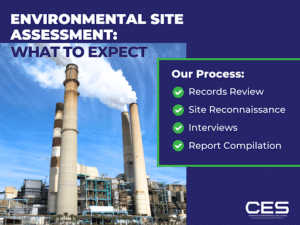“Why do I need a Phase I Environmental Site Assessment?” If this question comes to mind, let’s look at the potential risks of skipping this critical step.
Conducting due diligence is essential to protect yourself from hidden environmental risks when involved in a commercial or industrial real estate transaction. A Phase I Environmental Site Assessment (ESA) is a key step in evaluating a property’s history, identifying potential contamination, and ensuring compliance with environmental regulations. While it may seem unnecessary, skipping this assessment can mean financial and legal consequences, outweighing the upfront cost.
This blog will explore four critical reasons why a Phase I ESA is necessary for any property transaction and how it can safeguard your investment. But first, what is a Phase I ESA?
What Is a Phase I ESA, and Why Do I Need a Phase I Environmental Site Assessment?
A Phase I ESA is an environmental due diligence assessment that evaluates a property’s past and present use to identify potential contamination risks. This assessment is typically required by:
- Lenders, before approving a commercial real estate loan.
- Buyers and investors, to avoid purchasing contaminated properties.
- Developers, before starting new construction or redevelopment.
- Property owners looking to sell or refinance.
By reviewing historical records, conducting site inspections, and analyzing regulatory databases, a Phase I ESA helps determine whether a property poses environmental liabilities that could lead to costly cleanups or legal issues. Now, let’s examine why you should never skip this critical step.
Avoid Costly Environmental Liabilities
One of the most significant risks of purchasing a property without a Phase I ESA is unexpected contamination that could leave you financially responsible for expensive remediation efforts. Even if you had no role in causing the contamination, federal and state laws, such as the Comprehensive Environmental Response, Compensation, and Liability Act (CERCLA), can hold you accountable for cleanup costs.
For example, suppose you purchase a property once home to a gas station, dry cleaner, or manufacturing facility. In that case, there may be underground storage tanks (USTs), hazardous chemical residues, or soil and groundwater contamination that could require extensive remediation. Without a Phase I ESA, you might not discover these issues until after the purchase—when it is too late to renegotiate the deal.
By conducting a Phase I ESA, you can:
- Identify contamination risks early before finalizing a purchase.
- Negotiate a lower purchase price or have the seller handle remediation issues.
- Avoid inheriting financial responsibility for costly cleanups.
Skipping this step could lead to hundreds of thousands—or even millions—of dollars in unexpected environmental liabilities.
Ensure Compliance with Environmental Regulations
Federal, state, and local environmental regulations are in place to protect public health, natural resources, and property values. However, navigating these regulations can be complex, and failure to follow the law could result in legal consequences, fines, or project delays.
A Phase I ESA helps ensure compliance with environmental regulations by:
- Determining if contamination exists and whether regulatory reporting is required.
- Providing documentation for lender and regulatory approvals to move your project forward.
- Allowing you to qualify for liability protection under CERCLA’s Innocent Landowner Defense, which can protect you from being held responsible for pre-existing contamination.
Lenders and regulatory agencies often require a Phase I ESA before issuing financing or permits. Skipping this step could lead to denied funding, compliance issues, and major setbacks in your development plans.
Protect Your Investment and Property Value
Environmental contamination can significantly impact a property’s value, marketability, and future usability. A property with recognized environmental conditions (RECs) may:
- Be challenging to resell due to contamination concerns.
- Fail to qualify for loans or refinancing if lenders consider it a high-risk investment.
- Require costly cleanup efforts that diminish your profit margins.
Even if you do not plan to sell immediately, hidden contamination could become a long-term liability affecting your ability to develop, lease, or refinance the property. A Phase I ESA helps you decide whether to proceed with a transaction, negotiate better terms, or pursue additional assessments before committing to a purchase.
Prevent Project Delays and Unexpected Cleanup Costs
Skipping a Phase I Environmental Site Assessment (ESA) can lead to overlooked environmental hazards, including the presence of per- and polyfluoroalkyl substances (PFAS), commonly known as “forever chemicals.” These substances are persistent in the environment and have been linked to various health risks. Identifying potential PFAS contamination during a Phase I ESA is crucial for ensuring compliance with PFAS regulations and safeguarding against future liabilities.
By conducting a Phase I ESA upfront, you can:
- Uncover environmental risks early and plan accordingly.
- Avoid unanticipated project delays due to environmental investigations.
- Determine if further testing (Phase II ESA) is needed before investing significant resources into development.
Many real estate transactions and development projects depend on timely approvals, financing, and construction schedules. Discovering contamination after closing a deal or breaking ground can cause months or even years of delays, putting your entire investment at risk.
Do Not Take Unnecessary Risks—Schedule a Phase I ESA Today
Still wondering, “Why do I need a Phase I ESA?” A Phase I Environmental Site Assessment is a regulatory formality and a vital tool for protecting your financial interests, ensuring compliance, and making informed real estate decisions. Whether purchasing, financing, or developing commercial property, skipping this assessment can expose you to significant financial, legal, and operational risks.
At Creative Environmental Solutions, Inc., our environmental professionals provide thorough, reliable, and timely Phase I ESAs to help you confidently move forward. Contact us today to schedule your assessment and ensure your investment is safe, compliant, and profitable.





